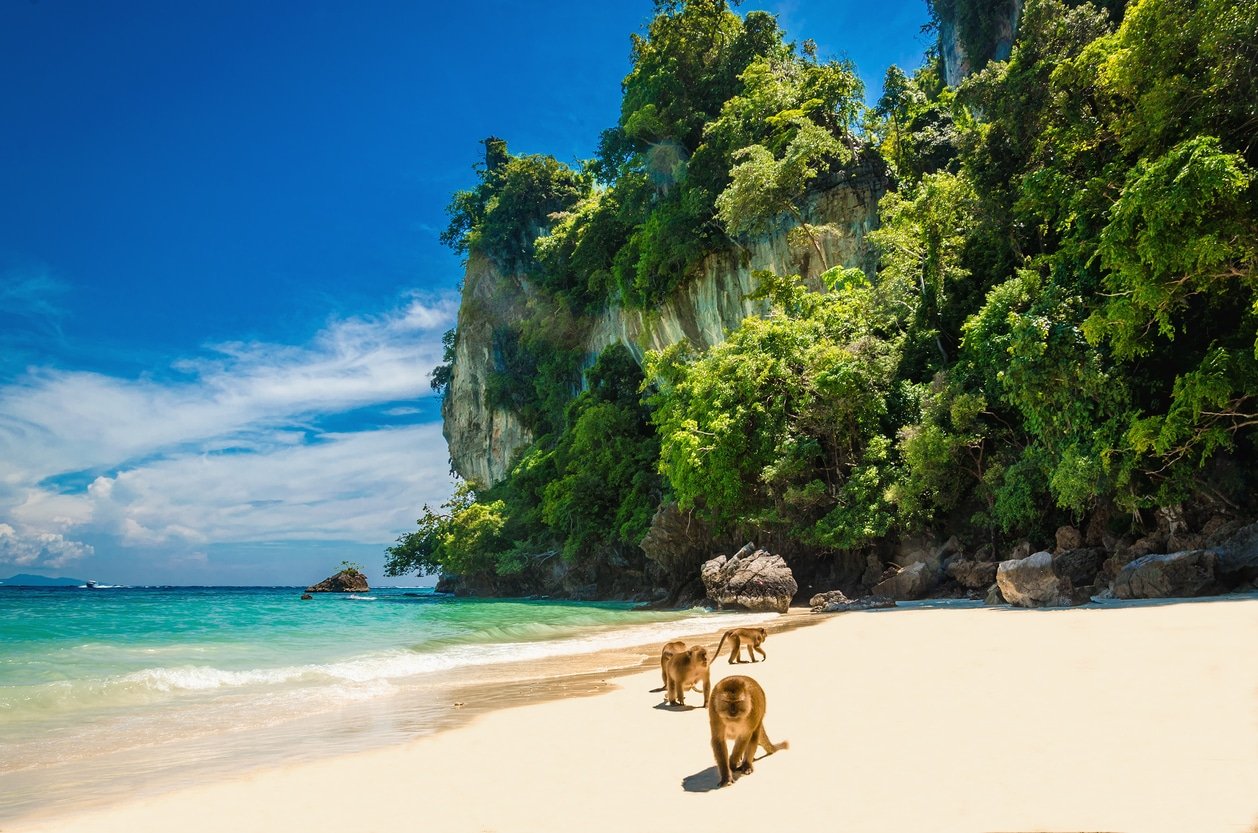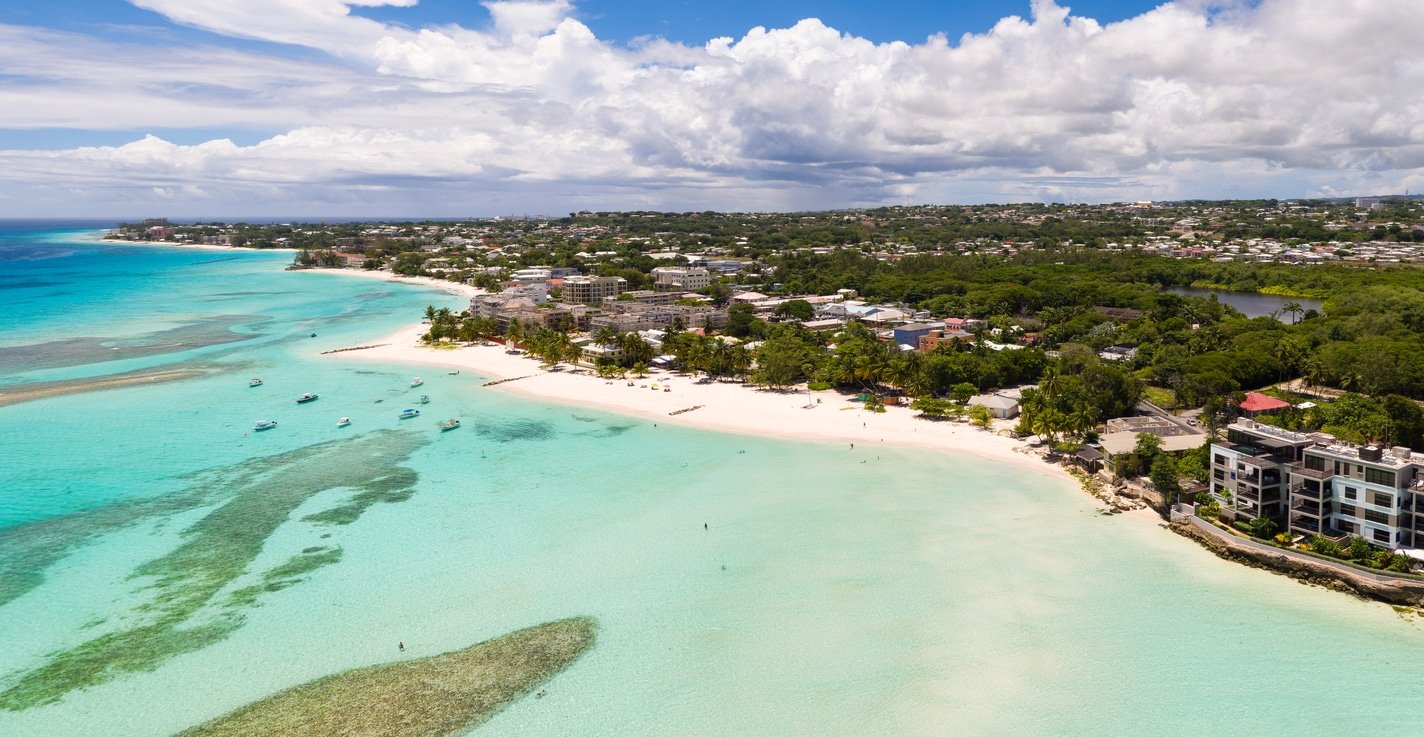20 Must-Know Insects & Bugs In The Bahamas That Bite & Sting
The Bahamas is a beautiful place to visit, and there’s no better way to experience it than by getting out into nature. Its beautiful beaches, crystal-clear waters, and vibrant coral reefs are well-known and for good reason!
However if you’re planning a trip, there are some insects and bugs in the Bahamas that you may encounter while you’re out there. So it’s good to know what they are, where they may be hiding, and how to deal with them.
This guide will tackle some of the most common biting and stinging insects and bugs in the Bahamas. If you’re likely to spend time outdoors on the islands, then this is a must read!
Here’s what you should know about these creatures and what you need to do when they bite you.
This article is for informational purposes. However if you get bitten while on holiday we always recommend seeking out a doctor, as some bug bites can cause complications and even severe allergic reactions.

20 Bugs & Insects In The Bahamas That Bite & Sting
1. Mosquitos
Mosquitos are everywhere in the world, and are flying insects that feed on the blood of other animals that are typically smaller than a housefly and have slender bodies with long, narrow wings. They can be found almost anywhere in the Bahamas, but are most commonly found near bodies of water, such as ponds or pools of rainwater and in tropical forests.
Mosquito bites tend to be very itchy. The initial sensation is like a small pinch or pinprick, but over time it becomes more painful as the saliva spreads through your body and begins to itch.
The bite itself does not need to be treated unless it becomes infected or causes an allergic reaction at the bite site. It is crucial to keep your skin clean so that you don’t get any infection.

2. No-see-ums
No-see-ums are tiny (hence the name), mosquito-like insects that are brownish-grey in colour with black wings that have white spots along their edges. They are also found everywhere throughout the Bahamas. However, in contrast to more developed areas, no-see-ums are worst on remote islands like Andros and West End, Grand Bahama.
The bite of No-see-ums will feel like a mosquito bite, a little itchy but not too bad. If you’re allergic to bites from biting insects, you may experience some swelling around the bite area that can last for several days.
You likely won’t have to treat the bite, but it may be wise to do so if your skin is sensitive or if an allergic reaction occurs after being stung. It’s also important to treat any cuts or wounds that are exposed to a no-see-um before they become infected with bacteria from their bite.

3. Sand Fleas
Sand fleas are tiny, sand-coloured insects that look like miniature crabs with pincers on their back legs. They have piercing-sucking mouthparts that they use to puncture the skin of their hosts and drink blood from them. These bugs in the Bahamas can usually found on sandy beaches or dunes.
Sand flea bites are usually not painful at first, but they cause itching and irritation within a few hours. Their bites are not dangerous to humans, but they’re very itchy and can make you sick if you have an allergic reaction to them.
The bite usually doesn’t need treatment because it poses no health risk. However, if you have a severe allergic reaction you will need medical attention from a doctor who can give you medication like epinephrine or steroids, which will help treat your symptoms until they resolve.

4. Bahamian Tarantulas
Bahamian Tarantulas are giant brown spiders with a yellow band on their front legs and a red band on their back legs.
You can find Bahamian Tarantulas in all kinds of places around the Bahamas, under rocks or logs, inside homes, and even in trees. They are nocturnal creatures who spend most of their time hiding away during daylight hours, so you probably won’t see them unless you’re out exploring at night.
The venom of Bahamian tarantulas can cause mild to moderate pain, but it is not lethal unless severely allergic. If a Bahamian tarantula bites you, wash the wound thoroughly with soap and water.
5. Bed Bugs
Bed bugs are oval-shaped, reddish-brown insects about 4 millimetres in length. They are usually found in beds, mattresses, and other areas around the home or in some hotels in the Bahamas.
Bed bug bites often leave behind red spots on the skin that can itch for up to two weeks. The edges can also be painful or cause swelling if you are allergic to them. You should see a doctor if you notice any signs of an allergic reaction after being bitten by a bed bug, like difficulty breathing.
Otherwise, most people who get bitten do not need medical treatment unless there is severe swelling or itching lasting more than two days.

6. Haitian Giant Centipede
The Haitian Giant Centipede has dark brown legs, which are banded with yellow stripes. Its body is yellowish-red or orange, sometimes with dark lines running down its sides.
It is found on some small islands in the Bahamas. It lives in moist forests where it likes to hide under logs, rocks, or other debris on the ground. They’ve even been found in hammocks so always double check before lying down.
The bite of a Haitian Giant Centipede is painful but not dangerous to humans unless they are allergic to the venom in its fangs.
If you are bitten by one of these Bahamas bugs, you should clean and disinfect your wound as soon as possible, then apply an antibiotic ointment or cream if necessary. Be sure not to squeeze your wound too much because this may cause more damage than good.
7. Ticks
Ticks are small, brown, or black arachnids that feed on the blood of mammals. They have eight legs but don’t have wings or a stinger. Ticks can be found in all parts of the Bahamas due to the tropical climate but are most prevalent in coastal areas.
The bite of a tick feels like a pinprick and may not even be noticed until later when symptoms appear. One common symptom of a tick bite is itching at the attachment site or around it.
In most cases, tick bites don’t need to be treated but you must remove the tick when you find it. However visit your doctor immediately if you notice redness, swelling, and pain at the bite site after being bitten by a tick. Unfortunately ticks carry some horrible diseases so if worried you should always get a doctor to look at any tick bite.
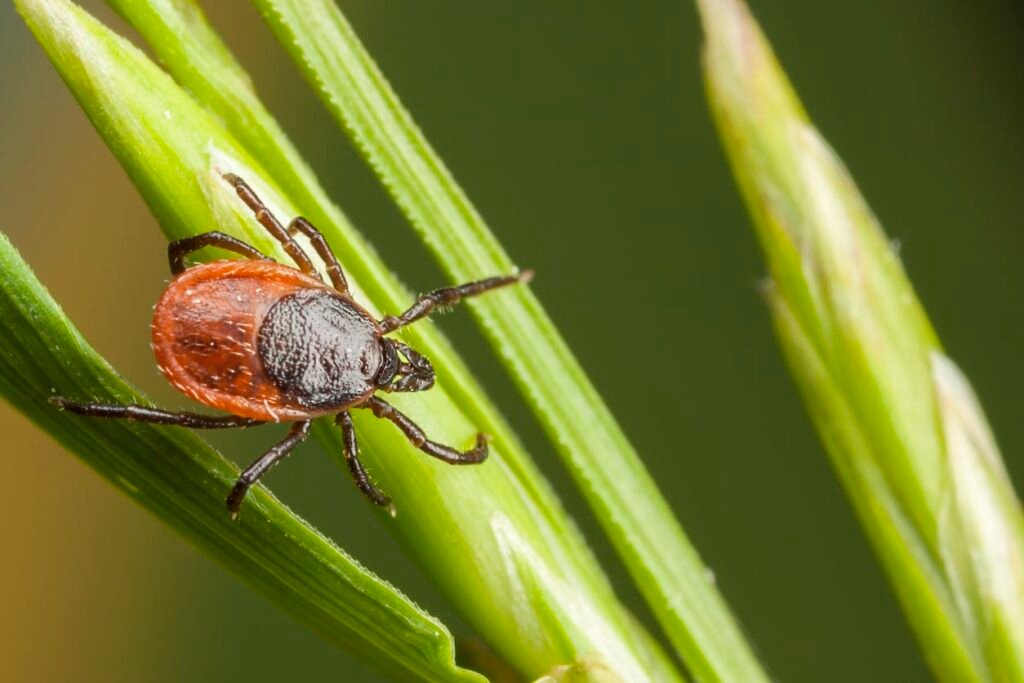
8. Bees
Bees are usually yellow or black with stripes on their bodies. In the Bahamas, bees are frequently seen. You will find many on Abaco.
A bee sting can be painful, but it isn’t dangerous unless you get multiple stings. If you’re allergic to bee venom, your reaction could be more severe than usual and even life-threatening.
Bee stings are usually not serious, but they should still be treated as soon as possible. While it is unlikely you need to go to the hospital, it is best to see a doctor if you have been stung by a bee.

9. Ants
Ants have small bodies and long legs, and also have strong jaws that allow them to bite through skin if threatened. Ants are found throughout the Bahamas but are more common near beaches where they can find water for their nests. They prefer sandy soil because it makes construction easier for them. However, they will build their nests anywhere from under tree roots to inside decaying logs.
The sting/bite of an ant can last several hours and can be pretty severe at times. The pain is usually localized to where they bit you, making it easy to identify where the bite happened.
Ants don’t tend to carry any diseases or viruses that affect humans, so there’s usually no need to treat their bites or stings with anything except soap and water or sanitized wipes.

10. Spiders
Spiders are arachnids that have eight legs and two body parts. Spiders are a common sight in the Bahamas and can be found in various environments, from tropical rainforests to sandy beaches.
Stings and bites from spiders are often not severe and dangerous to humans, but some species can be deadly if not treated immediately. If you’ve been bitten by a spider in the Bahamas then it’s always best to call your doctor or visit an urgent care clinic immediately.
11. Wasps
Wasps are typically black and yellow, although they can be brown or red. The wings of a wasp are usually transparent with black tips, but they may also be completely black. Wasps can be found in many environments around the Bahamas, including forests and fields. They often nest underground near water sources such as rivers or lakes so they can drink quickly when necessary.
Wasps’ stings are painful. They cause swelling and irritation, turning into itching as the venom starts working through your skin. If allergic to wasp stings, you may develop hives or severe swelling around your eyes or face.
If you get stung by a wasp, and there’s no allergic reaction, you don’t need to treat it because it will go away within 24 hours. However, if you’re allergic, you should seek medical attention immediately so that antihistamines can be administered before symptoms worsen.

12. Hornets
These bugs in the Bahamas are black and yellow striped with white dots on their abdomen. They have long legs and antennae, which they use to sense where they’re going and what’s around them.
Hornets can be found in trees and on flowers throughout the Bahamas. They’re attracted to sweet-smelling flowers like roses and honeysuckle, so if you see a lot of those nearby, it might be a sign that there’s a hornet’s nest nearby.
These insects will sting you if you get too close. Their sting can be painful but isn’t deadly unless you have an allergy or other condition that makes you more vulnerable than most people when stung by a hornet. If you do get stung by a hornet, gently clean the area with soap and water and apply an antibiotic ointment if necessary.

13. Black Flies
Black flies are named for their black bodies and red eyes. They have short, stubby wings that fly from one area of vegetation to another.
These are one of the more common bugs in the Bahamas. They can be found all over the islands, but their numbers vary by season. In summer, they’re most common in coastal areas. In winter, they tend to congregate around bodies of water with a lot of decomposing vegetation, like swamps.
If you get bitten by a black fly, it feels like a mosquito bite. The bite is itchy and irritating, but it shouldn’t hurt. Their bites of these bugs in the Bahamas can cause skin irritation and discomfort, and you might want to treat your bites if they itch or get worse over time because this could indicate an infection, such as cellulitis.

14. Cockroaches
The cockroach is an insect that has six legs and two antennae on its head. It is dark brown or black, with a yellowish-white colour on its underside.
Cockroaches are typically found outdoors under stones and rotting logs, but they often enter homes through sewer pipes or storm drains. In the Bahamas, they are usually found around garbage bins where they feed on food scraps left behind by humans.
The bite of a cockroach might not always be painful, but if you get bitten by a cockroach, it will swell up and become red and itchy for several days afterwards. If you get bitten by a cockroach, wash the area with soap and water immediately and apply an antibiotic cream to help prevent infection.
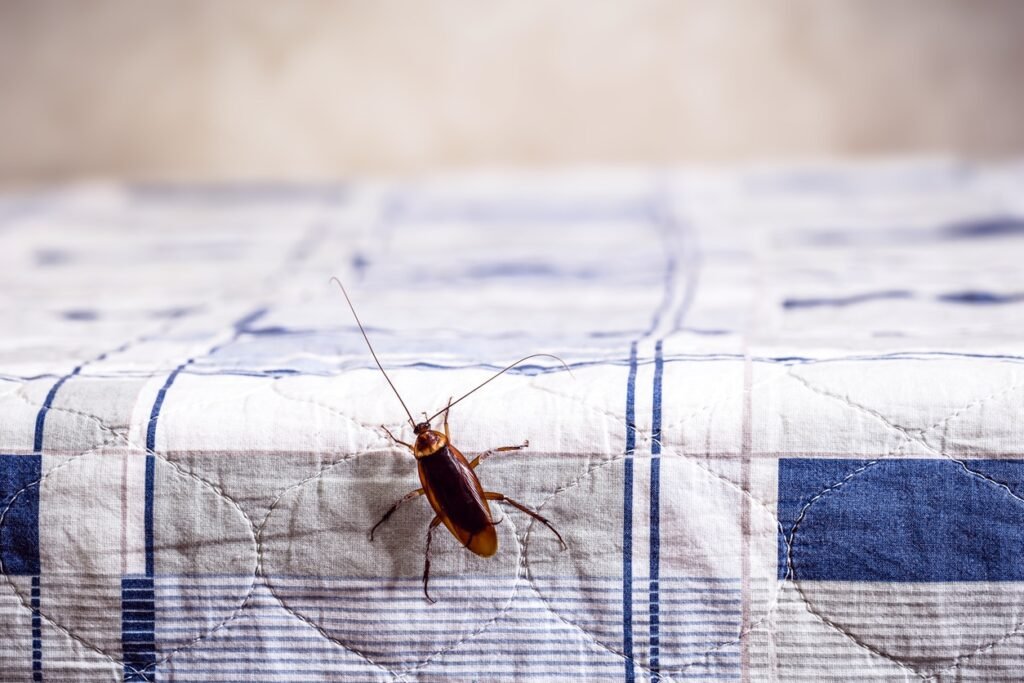
15. Praying Mantis
The praying mantis is large, green, and triangular. They have long necks and two pairs of wings. You can find these bugs in the Bahamas throughout the islands, especially near trees where they like to hide from predators. They are usually found in areas with many plants, such as parks and gardens.
The bite of a praying mantis is usually harmless, but it can cause pain and itching. The bite of a praying mantis shouldn’t need to be treated because it will go away on its own after a few hours.
16. Brown Recluse Spider
Brown Recluse Spiders are about 1-4 inches long and have a dark brown or black colour with a pattern of light spots.
It is a common spider found in the Bahamas, particularly on Grand Bahama Island. They are typically found in dark places such as closets, attics, and crawl spaces where they can hide from predators.
The bite of the brown recluse spider is poisonous, producing symptoms that can include nausea, vomiting, fever, and anaemia. Because of this risk, it’s essential to seek medical attention immediately if you think you’ve been bitten by one of these arachnids.
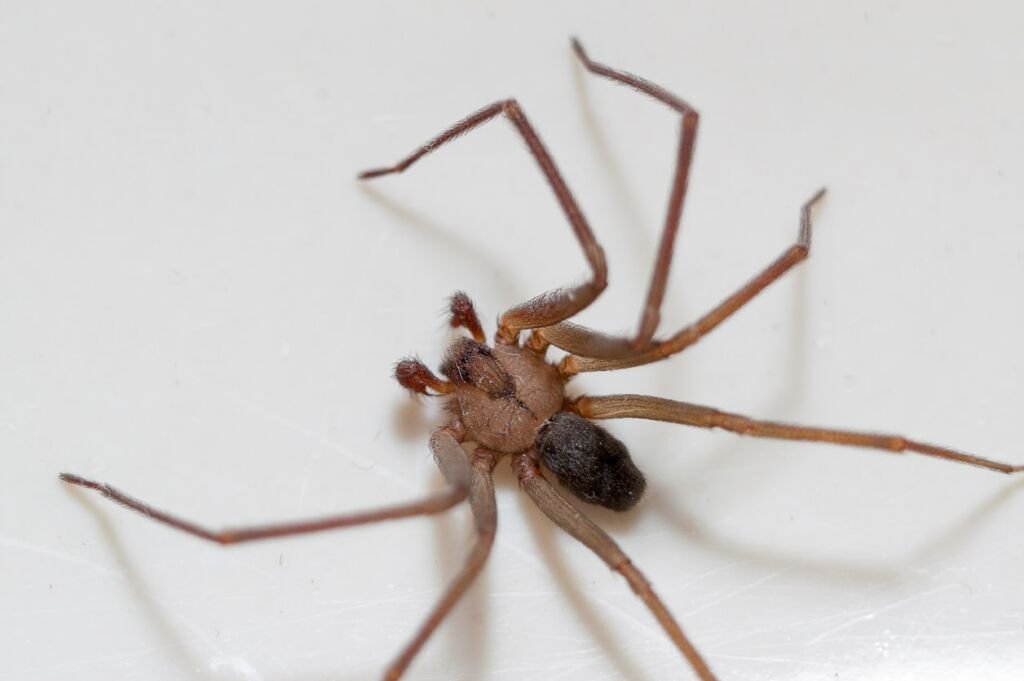
17. Sea Urchins
Sea urchins look like large, spiny balls, usually yellowish-brown, black or orange. They have long, sharp spikes sticking out of their body that can be up to two inches long. Sea urchins are common in the Bahamas and live in shallow waters, so they’re usually found on sandy shores or near rocky areas where there’s lots of algae or seaweed.
Sea urchins have a powerful venomous sting that can cause serious injury if stepped on or touched by bare skin or without protection.
If you get stung by one of these creatures, wash off your foot thoroughly with soap and water as soon as possible after contact because this will help prevent infection from occurring later.

18. Thimble Jellyfish
Thimble jellyfish are tiny, translucent creatures with bell-shaped bodies and tentacles at the bottom. They can be found in the shallow waters of the Bahamas, though they prefer waters that are less than 20 meters deep. They’re often found near coral reefs or seagrass beds.
The sting of the thimble jellyfish is mild, but it can leave you feeling itchy for up to 24 hours after you brush up against one of these creatures.
If you’ve been stung by a thimble jellyfish, you should keep an eye out for symptoms like redness or swelling in the area where you were stung and look out for an allergic response. If these symptoms appear, visit an urgent care facility immediately.
19. Sea Anemones
Sea anemones have a cylindrical shape and can be any colour from pink to purple to brown. They have tentacles that resemble flowers, and when you touch them, they will sting you. Sea anemones are usually found in shallow waters near rocky areas where they live. They are attached to rocks, coral, or seaweed.
The sting of a sea anemone is quite painful and can last up to three hours. To prevent infection, you should wash your skin with salt water after being stung by one of these creatures.
20. Guiana Striped Scorpion
The Guiana Striped Scorpion is a small, black, and yellow scorpion commonly found in the Bahamas. They are often seen in wooded areas but can also be found under rocks or logs.
They are not as dangerous as some other scorpions, but their sting is still excruciating and should be treated as soon as possible.
The venom of the Guiana Striped Scorpion causes pain and swelling at the site of the sting. Still, it does not usually cause any serious medical problems unless you have an allergy to scorpion stings, in which case you may need urgent medical attention.




